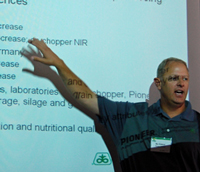 Researchers are usually the first to use new technology and when it comes to agricultural crop research, precision technology has made the development of new and better genetic varieties move at a much more rapid pace than ever before.
Researchers are usually the first to use new technology and when it comes to agricultural crop research, precision technology has made the development of new and better genetic varieties move at a much more rapid pace than ever before.
“Everything is precision now,” Pioneer Research Scientist Bill Curran told us last week during a Forage Media Day at the Pioneer Livestock Nutrition Center in Johnston, IA. He says genetic advances in hybrid performance have been driven by continued advances in field experimentation and data analysis.
“We utilize as much technology as possible,” Curran says. “We deploy things like precision guided tractors to ensure that we reduce the variability of misplanting. We want to control the controllables.”
 One significant advancement for developing new corn silage hybrids has been on-chopper NIR, or near-infrared spectroscopy. “On-chopper NIR is a tool that we use to measure quality and yield traits for a specific silage product that we are looking at,” Curran says. “That tool gives us an immediate answer. We know exactly what’s inside that corn hybrid within 20 seconds of chopping it.” The on-chopper NIR also allows the researchers to measure nearly all of the silage in a field faster and more efficiently than they could measure small samples.
One significant advancement for developing new corn silage hybrids has been on-chopper NIR, or near-infrared spectroscopy. “On-chopper NIR is a tool that we use to measure quality and yield traits for a specific silage product that we are looking at,” Curran says. “That tool gives us an immediate answer. We know exactly what’s inside that corn hybrid within 20 seconds of chopping it.” The on-chopper NIR also allows the researchers to measure nearly all of the silage in a field faster and more efficiently than they could measure small samples.
Curran says the practicality of using on-chopper NIR is not yet on the grower level, but there are developments being made that will bring this technology to the grower scale in the future.
Listen to an interview with Bill Curran here:
